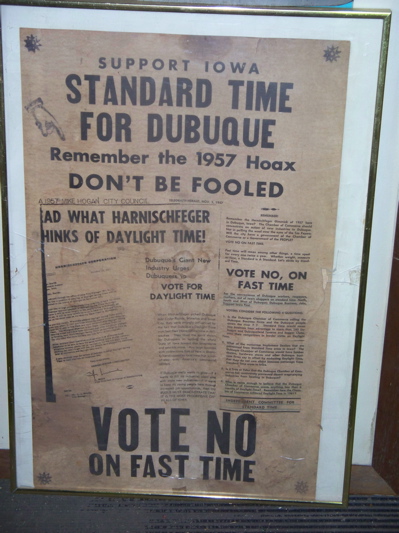Encyclopedia Dubuque
"Encyclopedia Dubuque is the online authority for all things Dubuque, written by the people who know the city best.”
Marshall Cohen—researcher and producer, CNN
Affiliated with the Local History Network of the State Historical Society of Iowa, and the Iowa Museum Association.
DAYLIGHT SAVINGS TIME: Difference between revisions
(New page: left|thumb|150px|DAYLIGHT SAVINGS TIME. The main purpose of Daylight Saving Time is to make better use of daylight. We change our clocks during the summer months to move ...) |
No edit summary |
||
| Line 1: | Line 1: | ||
[[Image:dst.jpg|left|thumb|150px|]]DAYLIGHT SAVINGS TIME. | [[Image:dst.jpg|left|thumb|150px|]]DAYLIGHT SAVINGS TIME. Daylight Saving Time (DST) is a system to reduce electricity usage by extending daylight hours. For eight months out of the year, the US and dozens of other countries follow DST, and for the remaining four months, revert back to standard time in order to take full advantage of the sunlight. On the second Sunday of March at 2 a.m., clocks move forward one hour. Then, on the first Sunday of November at 2 a.m., the clocks turn back an hour. The time shifts match the seasons: Clocks “spring” forward an hour in March and “fall” back in November. | ||
Daylight Saving Time was used in the United States during [[WORLD WAR I]] in order to save energy for war production by taking advantage of the later hours of daylight between April and October. During [[WORLD WAR II]], the federal government again required the states to observe the time change. Between the wars and after World War II, states and communities chose whether or not to observe Daylight Saving Time. | Benjamin Franklin appeared to have first mentioned it in 1784, when he wrote a letter to the editor of the '''Journal of Paris''' Daylight Saving Time was first used in the United States during [[WORLD WAR I]] in order to save energy for war production by taking advantage of the later hours of daylight between April and October. During [[WORLD WAR II]], the federal government again required the states to observe the time change. Between the wars and after World War II, states and communities chose whether or not to observe Daylight Saving Time. For years, the United States observed DST from the first Sunday of April to the last Sunday of October. (1) | ||
Daylight | In 1959 the Dubuque Committee for Daylight Time was again organized in May to contact legislators and promote the change. The committee was especially interested in seeking the change because both Illinois and Wisconsin had adopted the measure. (2) In 1966, Congress passed the Uniform Time Act, which standardized the length of Daylight Saving Time. | ||
In 2005, President George W. Bush extended DST an extra four weeks, officially taking effect in 2007. The March-November system the United States follows began in 2007, but the concept of “saving daylight” is much older. (3) | |||
--- | |||
Source: | |||
1. Ahmed, Saffeya, "Why and When the US Started Changing the Clock," Online: https://www.cnn.com/2019/11/03/us/daylight-saving-time-history-trnd/index.html | |||
2. "Daylight Time Group Formed by Dubuquers," ''Telegraph-Herald'', May 3, 1959, p. 1 | |||
3. Ahmed | |||
[[Category: Events]] | [[Category: Events]] | ||
Latest revision as of 21:57, 25 January 2021
DAYLIGHT SAVINGS TIME. Daylight Saving Time (DST) is a system to reduce electricity usage by extending daylight hours. For eight months out of the year, the US and dozens of other countries follow DST, and for the remaining four months, revert back to standard time in order to take full advantage of the sunlight. On the second Sunday of March at 2 a.m., clocks move forward one hour. Then, on the first Sunday of November at 2 a.m., the clocks turn back an hour. The time shifts match the seasons: Clocks “spring” forward an hour in March and “fall” back in November.
Benjamin Franklin appeared to have first mentioned it in 1784, when he wrote a letter to the editor of the Journal of Paris Daylight Saving Time was first used in the United States during WORLD WAR I in order to save energy for war production by taking advantage of the later hours of daylight between April and October. During WORLD WAR II, the federal government again required the states to observe the time change. Between the wars and after World War II, states and communities chose whether or not to observe Daylight Saving Time. For years, the United States observed DST from the first Sunday of April to the last Sunday of October. (1)
In 1959 the Dubuque Committee for Daylight Time was again organized in May to contact legislators and promote the change. The committee was especially interested in seeking the change because both Illinois and Wisconsin had adopted the measure. (2) In 1966, Congress passed the Uniform Time Act, which standardized the length of Daylight Saving Time.
In 2005, President George W. Bush extended DST an extra four weeks, officially taking effect in 2007. The March-November system the United States follows began in 2007, but the concept of “saving daylight” is much older. (3)
---
Source:
1. Ahmed, Saffeya, "Why and When the US Started Changing the Clock," Online: https://www.cnn.com/2019/11/03/us/daylight-saving-time-history-trnd/index.html
2. "Daylight Time Group Formed by Dubuquers," Telegraph-Herald, May 3, 1959, p. 1
3. Ahmed


